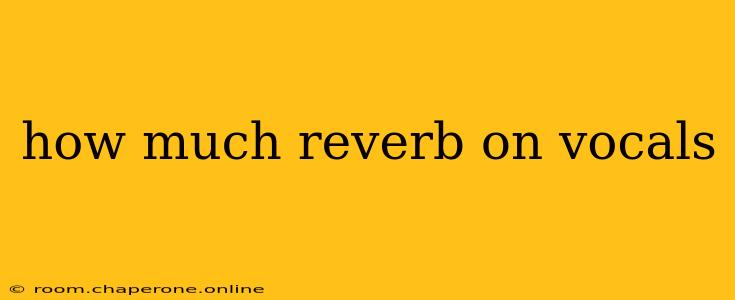How Much Reverb on Vocals? Finding the Sweet Spot for Your Mix
The question of how much reverb on vocals is a common one, and the answer, unfortunately, isn't a simple number. The ideal amount depends heavily on several factors, including genre, vocal style, the overall mix, and your personal aesthetic. Instead of aiming for a specific percentage, let's explore the crucial elements that will guide you towards achieving the perfect vocal reverb.
Understanding the Role of Reverb on Vocals
Reverb simulates the acoustic environment of a space. It adds depth, spaciousness, and a sense of realism to vocals, helping them sit better within a mix. Too little reverb can make vocals sound dry and lifeless, while too much can muddy the mix and make the vocals sound distant or unnatural. The goal is to find a balance that enhances the vocal performance without overpowering it.
Factors Influencing the Amount of Reverb
Several key factors determine the appropriate level of reverb:
-
Genre: A heavy metal track will likely use less reverb than a shoegaze ballad. Consider the sonic landscape of your genre. Heavy genres often prefer a drier, more upfront vocal sound, while genres like ambient or dream pop often utilize lush, expansive reverb.
-
Vocal Style: A powerful, belting vocal might benefit from a subtler reverb to maintain clarity, whereas a more delicate, intimate vocal might benefit from a more pronounced reverb to add warmth and intimacy.
-
Vocal Performance: The quality of the recording itself matters. A technically superb recording might need less reverb to maintain its detail, while a less-perfect recording may benefit from a touch more reverb to mask minor imperfections. However, never use reverb as a crutch to cover up poor recording techniques.
-
Mix Context: How does the vocal sit within the overall arrangement? If your track has a dense arrangement with many instruments, you might need less reverb to avoid muddiness. A sparser arrangement can often accommodate more reverb.
-
Room Size Simulation: Reverb plugins often allow you to simulate different room sizes. A large hall reverb will naturally sound more expansive than a smaller room reverb. Experiment with different room sizes to find what suits your vocal and song best.
-
Reverb Type: Different reverb types (plate, hall, room, spring) have different characteristics. A plate reverb might be suitable for a smooth, polished sound, whereas a spring reverb could add a vintage, quirky texture.
Practical Tips for Achieving the Right Amount of Reverb
-
Start Small: Begin with a very low amount of reverb and gradually increase it while listening critically.
-
A/B Testing: Continuously compare your mix with and without reverb to hear the difference.
-
Solo the Vocal: Listen to the vocal with reverb on its own to assess its clarity and character.
-
Listen in Different Contexts: Assess your mix through different playback systems (headphones, monitors, car stereo) to ensure the reverb sounds good across various contexts.
-
Use a Mix Assistant: Many Digital Audio Workstations (DAWs) have built-in mix assistants that can offer suggestions for your reverb settings.
-
Utilize EQ: If your reverb is muddying the mix, use EQ to carve out frequencies that conflict with the vocal or other elements.
-
Experiment with Early Reflections: Early reflections are the initial reflections of sound that occur in a room. These can add a sense of space without making the reverb sound too washed out. Many plugins allow you to control the amount of early reflections.
Ultimately, the "right" amount of reverb is subjective and dependent on artistic preference. There's no magic number; it's about finding the sweet spot that enhances your vocal performance without overwhelming the overall mix. Experiment, listen carefully, and trust your ears!

